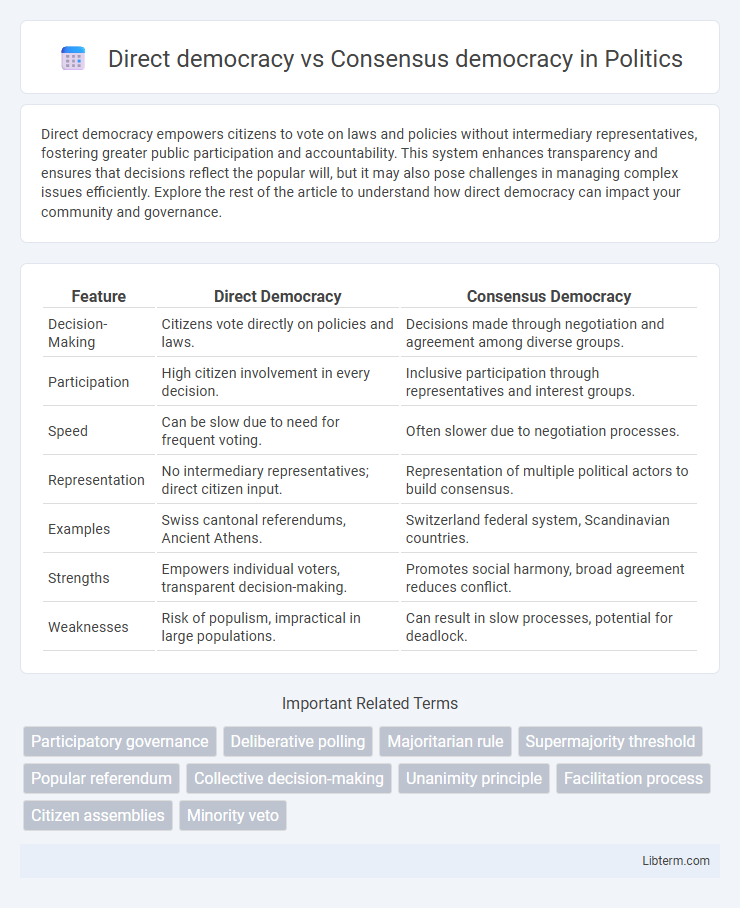Direct democracy empowers citizens to vote on laws and policies without intermediary representatives, fostering greater public participation and accountability. This system enhances transparency and ensures that decisions reflect the popular will, but it may also pose challenges in managing complex issues efficiently. Explore the rest of the article to understand how direct democracy can impact your community and governance.
Table of Comparison
| Feature | Direct Democracy | Consensus Democracy |
|---|---|---|
| Decision-Making | Citizens vote directly on policies and laws. | Decisions made through negotiation and agreement among diverse groups. |
| Participation | High citizen involvement in every decision. | Inclusive participation through representatives and interest groups. |
| Speed | Can be slow due to need for frequent voting. | Often slower due to negotiation processes. |
| Representation | No intermediary representatives; direct citizen input. | Representation of multiple political actors to build consensus. |
| Examples | Swiss cantonal referendums, Ancient Athens. | Switzerland federal system, Scandinavian countries. |
| Strengths | Empowers individual voters, transparent decision-making. | Promotes social harmony, broad agreement reduces conflict. |
| Weaknesses | Risk of populism, impractical in large populations. | Can result in slow processes, potential for deadlock. |
Introduction to Direct Democracy and Consensus Democracy
Direct democracy empowers citizens to make decisions through referendums and initiatives, bypassing representative intermediaries and enhancing political participation. Consensus democracy emphasizes broad agreement among diverse political actors, fostering cooperation and power-sharing to accommodate multiple viewpoints within pluralistic societies. Both models shape governance by balancing citizen involvement and inclusive decision-making mechanisms.
Core Principles of Direct Democracy
Direct democracy centers on the principle of popular sovereignty, where citizens directly participate in decision-making processes without intermediary representatives. Core principles include frequent referendums, initiatives, and recalls, ensuring that the electorate has direct control over laws and policies. This system contrasts with consensus democracy, which relies on negotiation and power-sharing among elected representatives to achieve broad agreement.
Key Features of Consensus Democracy
Consensus democracy emphasizes broad coalition-building, power-sharing among diverse political groups, and extensive negotiation processes to achieve inclusive decision-making. It prioritizes proportional representation, multiple veto points, and decentralization to ensure minority rights and prevent domination by a single party. This system enhances political stability by fostering collaboration and mutual agreement across competing interests.
Historical Evolution of Both Systems
Direct democracy traces its origins to ancient Athens around the 5th century BCE, where citizens participated directly in decision-making assemblies, influencing modern referendum and initiative processes. Consensus democracy evolved primarily in post-World War II Western Europe, emphasizing power-sharing, proportional representation, and inclusive decision-making to maintain political stability in diverse societies. Both systems reflect distinct historical responses: direct democracy prioritizes individual involvement rooted in classical antiquity, whereas consensus democracy focuses on collaborative governance shaped by modern pluralistic states.
Decision-Making Processes Compared
Direct democracy empowers citizens to make decisions through referendums and initiatives, enabling immediate public participation without intermediary representatives. Consensus democracy relies on negotiation and compromise among diverse political actors and interest groups to reach collective decisions, promoting inclusiveness and broad agreement. Decision-making in direct democracy is quicker but can be less deliberative, whereas consensus democracy emphasizes thorough debate and compromise, often resulting in slower but more stable policy outcomes.
Advantages of Direct Democracy
Direct democracy allows citizens to participate actively in decision-making processes, increasing political engagement and accountability. It enables faster policy implementation by reducing reliance on intermediaries, ensuring that public will is directly reflected in laws. The system also promotes transparency and reduces the risk of corruption by minimizing the influence of political elites and special interest groups.
Strengths of Consensus Democracy
Consensus democracy excels in fostering inclusive decision-making by encouraging broad participation and cooperation among diverse political groups, which leads to more stable and representative policies. It reduces polarization through power-sharing mechanisms and coalition governments, ensuring minority voices are heard and respected. This collaborative approach enhances legitimacy and trust in the political system, contributing to social cohesion and long-term governance stability.
Challenges and Criticisms of Each Model
Direct democracy faces challenges including the risk of populism, where majority rule may overlook minority rights, and the complexity of involving all citizens in decision-making can lead to voter fatigue and lower participation. Consensus democracy often encounters difficulties in achieving timely decisions due to the need for broad agreement; power-sharing arrangements may result in political gridlock and diluted policy outcomes. Both models struggle with balancing efficiency and inclusiveness, as direct democracy may sacrifice deliberation depth, while consensus democracy can hinder swift governance.
Case Studies: Countries Practicing Each System
Switzerland exemplifies direct democracy with frequent referenda allowing citizens to propose and vote on laws, reflecting a highly participative political culture. In contrast, consensus democracy is characteristic of the Netherlands, where coalition governments and power-sharing across multiple parties promote broad agreement and inclusion in decision-making. These models demonstrate the practical application of direct citizen involvement versus negotiated political compromise in parliamentary systems.
Future Trends and Implications for Governance
Direct democracy's future trends emphasize increased digital participation tools, enabling real-time citizen input and greater transparency in decision-making processes. Consensus democracy is evolving towards more inclusive governance structures that prioritize collaborative policy-making and conflict resolution among diverse stakeholders. These shifts suggest a hybrid governance model blending direct citizen engagement with consensus-driven deliberation to enhance legitimacy and responsiveness.
Direct democracy Infographic

 libterm.com
libterm.com